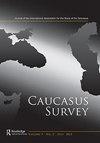可见与不可见的种族:1943-1956年驱逐期间卡尔梅克人的母语和宗教信仰
IF 0.4
Q3 AREA STUDIES
引用次数: 0
摘要
本文致力于研究卡尔梅克历史上的一个重要时期——卡尔梅克人被驱逐到西伯利亚(1943-1956)及其文化影响,但人类学家和社会学家对这一时期的研究还不够充分。它的目的是展示在不利的社会和政治环境中被流放的卡尔梅克人的耻辱如何影响他们的语言和宗教行为。这些问题是建立苏维埃卡尔梅克民族进程的一部分,这一进程始于1920年苏维埃政权在卡尔梅克大草原上建立之后,是强迫人民现代化政治领域的延续。西伯利亚的卡尔梅克人试图隐藏带有种族特征的文化形式,避免在公共场合说卡尔梅克语,并隐藏他们的宗教信仰。本文采用了作者在2004年至2019年期间以采访的形式收集的实地资料,并出版了有关流亡的回忆录。本文章由计算机程序翻译,如有差异,请以英文原文为准。
Visible and Invisible Ethnicity: Native Language and Religiosity Among the Kalmyks during the Years of Deportation, 1943–1956
This article is devoted to an important period, as yet insufficiently studied by anthropologists and sociologists, in the history of Kalmykia – the deportation of the Kalmyks to Siberia (1943–1956) and its cultural implications. Its aim is to show how the stigmatization of the exiled Kalmyks in an unfavorable social and political environment influenced their linguistic and religious behavior. These issues are part of the process of creating a Soviet Kalmyk ethnicity, which began after the establishment of Soviet power on the Kalmyk steppe in 1920 and was a continuation in the realm of politics of the forced modernization of the people. Kalmyks in Siberia tried to hide ethnically marked forms of culture, abstaining from speaking Kalmyk in public and hiding their religiosity. The article uses field materials collected by the author in the form of interviews conducted between 2004 and 2019 and published memoirs about exile.
求助全文
通过发布文献求助,成功后即可免费获取论文全文。
去求助
来源期刊

Caucasus Survey
Arts and Humanities-History
CiteScore
1.30
自引率
9.10%
发文量
4
期刊介绍:
Caucasus Survey is a new peer-reviewed, multidisciplinary and independent journal, concerned with the study of the Caucasus – the independent republics of Armenia, Azerbaijan and Georgia, de facto entities in the area and the North Caucasian republics and regions of the Russian Federation. Also covered are issues relating to the Republic of Kalmykia, Crimea, the Cossacks, Nogays, and Caucasian diasporas. Caucasus Survey aims to advance an area studies tradition in the humanities and social sciences about and from the Caucasus, connecting this tradition with core disciplinary concerns in the fields of history, political science, sociology, anthropology, cultural and religious studies, economics, political geography and demography, security, war and peace studies, and social psychology. Research enhancing understanding of the region’s conflicts and relations between the Russian Federation and the Caucasus, internationally and domestically with regard to the North Caucasus, features high in our concerns.
 求助内容:
求助内容: 应助结果提醒方式:
应助结果提醒方式:


